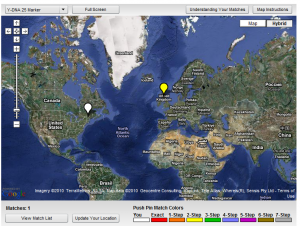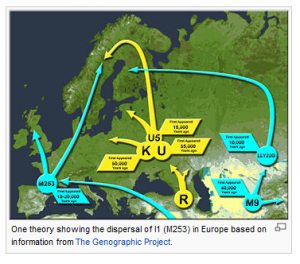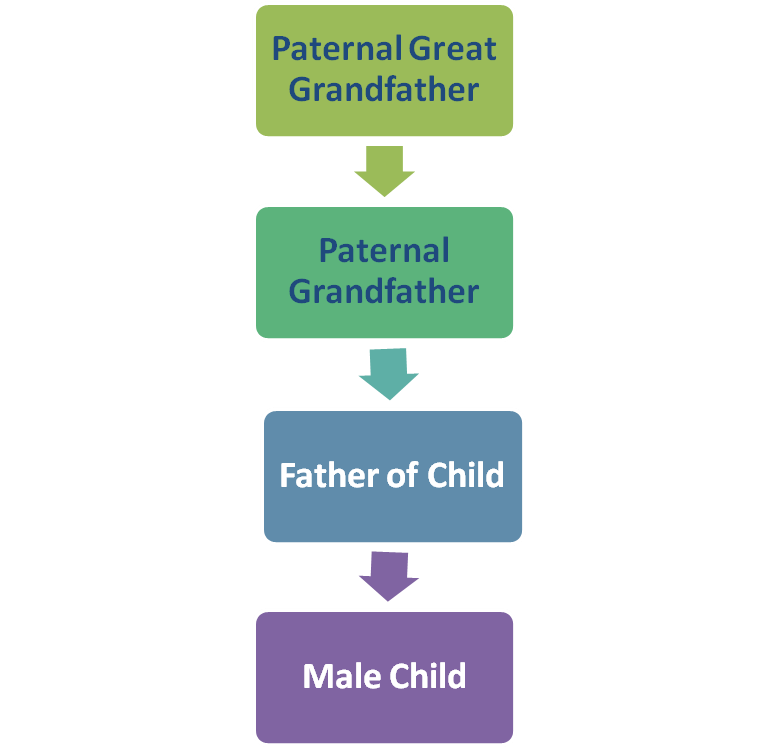YDNA Surname Testing for Brickwalls
Goal of our YDNA project
GOAL: My ongoing goal is to make KERR connections that would take our KERR genealogy research out of Quebec and back to a specific place in Ireland. The Ultimate Goal is to get those Irish Kerrs back to the border region of Scotland…. but one step at a time. I use genetic genealogy along with traditional methods to research. (Researching with DNA appeals to the geek in me having retired from a medical research genetics lab)
Testing
In 2005, we tested my brother’s YDNA for genetic genealogy purposes. Why test my brother and not me? The reason is because I don’t have a Y chromosome being female. Females have two X chromosomes.
The YDNA is passed from father to son over the ages on the sex linked Y chromosome. Unless there is a non-paternal event such as an adoption, surname change or someone in the woodpile, the YDNA should be much the same generation to generation (barring a mutation or two). Thanks to my brother we could follow the YDNA along the Kerr line as illustrated in my graphic below.
Results to Date
My brother participated in the KERR/CARR surname project at Family Tree DNA. We first tested for 25 markers then upgraded in 2009 to 67 markers.

The results were excellent. The match was 63 out of 67 markers. The other fellow had the exact same name as my brother…right down to the middle name. Talk about serendipity!
“That’s about as good as it gets.” Bennett Greenspan, the CEO and president of FTDNA told me at the SCGS Jamboree in Burbank, California this past June.
The most recent common ancestor (TMRCA) was probably only 3 or 4 generations back (at the very most 5 generations). (See these links for more information on genetic distance and TMRCA calculations).
I compared notes with my brother’s namesake a few years ago and recently reconnected to catch up with his research. We swapped data and I’m actively researching his line. I’m also researching another 37 marker match, a CARR. So far we haven’t found our mutual ancestor but we are working on it.
I’ve checked my brother’s results versus the YDNA databases at Ancestry.com and the Sorenson Molecular Genealogy Foundaton (SMGF) database. Ancestry has one match (although more distant than our FTDNA matches). I didn’t find any close matches at SMGF.
Ysearch.org is another database sponsored by FTDNA. The only match I found at Ysearch was the same fellow that matched 63 out of 67 markers above. At least I assume it is him, as this individual had the same genetic profile as my brother’s match at FTDNA. (To protect privacy, no names appear on open websites.)
We used genetic genealogy to rule out another group of Quebec KERRs that I had been trying to connect with for at least ten years. Negative results are important too and can save one research time.
Haplogroup I1
Haplogroups show your deepest ancestral orgins dating back thousands of years.

My brother’s Haplogroup is I1, based on the presence of the SNP M253. SNP is an acronym for “single nucleotide polymorphism”. This is a single change in the DNA nucleotide sequence. (see FTDNA’s GLOSSARY)
Haplogroup I1 is a Y chromosome haplogroup occuring in the greatest frequency in Scandinavia which fits with the story of the KERR/CARR/Kjarrs (and other name variations) which are thought to have orginated with the Vikings, then moved down through France then up into the UK.
(Note – to follow active discussions about the latest SNPs associated with various haplogroups, check out the genealogy-DNA list or the medical literature at pubmed).
We have autosomal and mitochondrial DNA testing in the works to add to the YDNA story. More on that later. Genetic DNA testing has given us new avenues to explore and we hope to make more cousin connections.
So….Y DNA? Y Not?
Why do YDNA testing, well why not? It can save you research time and perhaps break down that brickwall. You too might find that serendipitious match.
==> To Visit Family Tree DNA
—
An Open Message (my plea) to any KERRS, CARRS, and surname variants: Please take a YDNA test at Family Tree DNA to learn more about your ancestors. In doing so you may find cousin connections that you may not even known existed. We may be cousins. Visit the KERR/CARR YDNA surname study for more information.
© Copyright 2010 Joan Miller
